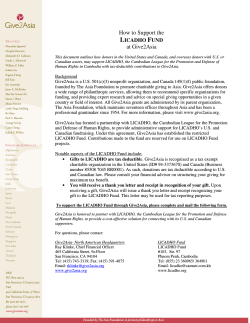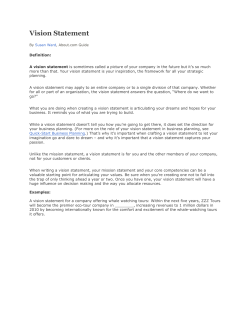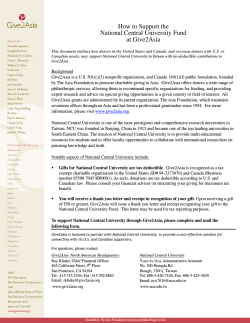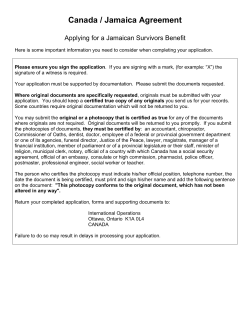
A New Canadian Standard for Sample Collection and Handling to of Care
A New Canadian Standard for Sample Collection and Handling to Improve Patient Safety and Quality of Care Sheila Woodcock, MBA, ART, FCSMLS(D) QSE Consulting Inc Chair, CSA Technical Committee Z252 Medical Laboratory Quality Systems Global Standardization of the Preanalytic Process of Laboratory Testing JCCLS Symposium April 4, 2013 Outline of the presentation: • Global standardization • Patient safety • About CSA • Importance of pre-examination processes • The new Canadian standard – – – – Target audience Scope and terminology Content Next steps 2 Global Standardization The dynamic force in current globalization - the thing that gives it its unique character - is the new found power for individuals to collaborate and compete globally. Thomas L. Friedman NY Times journalist Author of “The World is Flat” 3 WHO World Alliance for Patient Safety 2004 4 5 From Joint Commission U.S.A. © The Joint Commission, 2013. Reprinted with permission 6 Canadian Standards Association History • Founded in 1919 as the Canadian Engineering Standards Association (CESA) • Federally chartered to create standards • The first standards issued by CESA were for steel railway bridges, in 1920 • In 1927 CESA published the Canadian Electrical Code • 1940 CESA assumed responsibility for testing and certifying electrical products intended for sale and installation in Canada. Canadian Standards Association History … continued • 1944 renamed Canadian Standards Association • 1946 introduced the certification mark now widely recognized • In the 1960s, CSA developed national Occupational Health and Safety Standards, creating standards for headgear and safety shoes • 1970s, the CSA began to expand its involvement in consumer standards, including bicycles, credit cards, and child resistant packaging for drugs. CSA Today • Not-for-profit membership-based association serving business, industry, government, and consumers in Canada and the global marketplace • Re-branded in 2012 with three major sectors: – the Canadian Standards Association - for standards development, information products, sale of publications, training, and membership services – CSA International - for product testing and certification – OnSpeX- for consumer product evaluation based in Cleveland, Ohio • 57 areas of specialization – climate change – business management – safety and performance standards, including those for electrical and electronic equipment, industrial equipment and construction materials – health care • 7,500 members involved in standards development • Accredited by Standards Council of Canada CSA Health Care Program • 220 standards in 15 subject areas • Improving patient safety (i.e., reducing adverse events or critical incidents) • Increasing the safety of health care workers (i.e., reducing workplace accidents and infections) • Ensuring the electrical safety of medical devices • Promoting the safe design, construction, and management of health care facilities and their subsystems; and • Establishing secure, reliable health information systems. • In addition a number of guidance and support documents have also been published. Examples of High‐profile CSA Health Care Standards • Z902, Blood and blood components (management system standard to enhance the quality and safety of blood collection and transfusion) • Z900 series, Cells, tissues, and organs for transplantation and assisted reproduction (management system standards to improve the safer handling of human cells, tissues, and organs for human transplant). • These standards are referenced in safety regulations under Health Canada’s Food and Drugs Act which came into force on December 7, 2007. CSA Technical Committee Z252 Medical Laboratory Quality Systems • Established in 1988 under the authority of the Strategic Steering Committee on Health Care • Balanced matrix membership: – – – – producer interest, user interest, regulatory interest, and general interest • Serves as the Canadian Mirror Committee to ISO/TC 212 Clinical Laboratory Testing and In Vitro Diagnostic Test Systems, ensuring active Canadian delegate participation at ISO/TC 212 meetings. Current TC Z252 Activities • Participation in ISO/TC 212 Clinical laboratory testing and in vitro diagnostic test systems – – – – WG1, Quality and competence in the medical laboratory WG2, Reference systems WG3, In vitro diagnostic products WG4, Antimicrobial susceptibility testing • Periodic review of existing standards portfolio documents • Contribution to Infoway work on standardization of nomenclature • Communication and cooperation with other national organizations: Health Canada, Accreditation Canada, CAPACP, CSCC, CSMLS, etc. • Identification of need for new national standards or guidelines. – Evaluation of laboratory developed methods – Antimicrobial susceptibility testing Z316.7 New Standard for Pre-Examination Processes Z316.7 - 12 Primary sample collection facilities and medical laboratories – Patient safety and quality of care - Requirements for collecting, transporting, and storing samples 14 Technical Sub-Committee CSA TSC Z252.10 • Anne-Marie Martel, M.T., Chair • Michael Noble, MD,FRCPC, Vice-Chair • Sheila Woodcock, ART, MBA, FCSMLS(D), Vice-Chair • Representatives of the medical laboratory community from across Canada 15 Z316.7 New Standard for Pre-Examination Processes History: White paper published in Canadian Journal of Medical Laboratory Science1: 1Is there a role for Medical Laboratory Science in Patient Safety in Canada? Davis, Kurt H., CJMLS, Vol. 70, No3, June 2008. 16 Z316.7 New Standard for Pre-Examination Processes Rationale: • Lack of standardisation in training and education programs; • Limited availability of guidance documents in Canada for specimen procurement; • Absence, in many provinces, of regulatory control of specimen procurement; • Lack of regulatory bodies for medical technologists and medical laboratory assistants in some provinces. 17 Z316.7 New Standard for Pre-Examination Processes Importance of pre-examination processes • Up to 85% of medical decisions are based on results from the medical laboratory2; • Physical safety of the patient; • The majority of errors occur in the pre-examination phase. 2 Foubister, V,: Bench press: The technologist/technician shortfall is putting the squeeze on laboratories nationwide, CAP Today, September 2000. 18 Z316.7 New Standard for Pre-Examination Processes • Errors in Laboratory Medicine: – Pre-analytical: 31.6% to 75% – Analytical: 13.3% to 31.6% – Post-analytical: 9% to 31.6% preanalytical analytical postanalytical Bonini P, Plebani M. Ceriotti F. Errors in laboratory medicine. Clin Chem 2002; 48:691-8. 19 Z316.7 New Standard for Pre-Examination Processes • Pre-analytical variability: the dark side of the moon in laboratory testing: – “Lack of standardized procedures for sample collection, including patient preparation, specimen acquisition, handling and storage, account for up to 93% of the errors currently encountered within the entire diagnostic process.” Lippi G, Guidi GC, Mattiuzzi C, Plebani M. Preanalytical variability: the dark side of the moon in laboratory testing., Clin Chem Lab Med. 2006;44(4):358-65. 20 Z316.7 New Standard for Pre-Examination Processes Target audience: Facilities performing pre-examination activities: • • • • • • Medical laboratories; Hospitals and associated collection centres; Nursing Homes and other special care facilities; Private and public collection service organizations; Doctor’s offices; Home collections. 21 Z316.7 New Standard for Pre-Examination Processes Documents used in the standard development: • OPTMQ Rules of practice (source documents) • ISO 15189:2007 • CLSI Standards and Guidelines • Health Canada Infection Control Guidelines 22 Z316.7 New Standard for Pre-Examination Processes Application of the standard: • Stand alone or in conjunction with ISO15189 • Adoption by accreditation bodies • Adoption by health ministries 23 Z316.7 New Standard for Pre-Examination Processes Scope of the standard: • To establish quality requirements for: – Collection – Transport, and – Storage • To ensure patient safety and quality of care are at the forefront of the pre-examination process. Beyond the scope: – Specific procedures – POCT (covered in CAN/CSA-Z22870) 24 Z316.7 New Standard for Pre-Examination Processes Terminology used in the standard: • Pre-examination activities: steps starting with the sample request, followed by the preparation of the patient, collection of the primary sample, transport of the sample to and within a laboratory, accessioning of the sample, stabilization of the sample and storage of the sample, and ending when the examination activities begins. “pre-analytical phase” 25 Pre-examination Processes flowchart Blank slide for large photos only Z316.7 New Standard for Pre-Examination Processes Terminology used in the standard: • Primary sample or specimen: the sample collected from or by a patient, which is still in its original collection container, and is to be used for examination purposes. • Sample or aliquot: a portion removed from the primary sample that is used for examination purposes. Note: the term sample was also used to include both the primary sample and sample in situations such as handling, transport and storage. 27 Z316.7 New Standard for Pre-Examination Processes Contents: 1-Scope 2-Reference publications 3-Definitions 4-Pre-examination processes 5-Quality management system – ISO 15189-07 (Annex A) – ISO 9001 – CLSI GP26-A4 28 Z316.7 New Standard for Pre-Examination Processes 6-Patient safety and quality of care – Patient communication – Ethics – Privacy – Confidentiality – Patient physical safety – Prevention of errors and nonconformities 29 Z316.7 New Standard for Pre-Examination Processes 7-Facility conditions – – – – Space allocation and design Patient and personnel comfort and safety Controlled access Housekeeping 8-External services, supplies, and equipment – Expiry dates – Reusable vs sterile supplies – Personal protective equipment (PPE) 30 Z316.7 New Standard for Pre-Examination Processes 9-Personnel – Training – Records – Competence assessments 10- Infection prevention and control: – Patient waiting areas – Hand hygiene – Collecting from patients requiring additional precautions 31 Z316.7 New Standard for Pre-Examination Processes 11- Primary sample collection – – – – – – – – Instructions Sample requests Verification of the patient’s identification Verification of sample request form Patient consent Pre-examination requirements Phlebotomy procedures Special requirements for samples by discipline 32 Z316.7 New Standard for Pre-Examination Processes 12- Identification of samples 13- Sample integrity – Criteria for sample rejection – Phlebotomy procedures 14- Sample receipt, assessment, processing and storage 15- Transport of samples Including: – – Automated (pneumatic tube) delivery system Home collections 33 Z316.7 New Standard for Pre-Examination Processes Informative annexes: A: Quality management requirements: adapted from section 4 of ISO15189:2007. B: Biochemistry samples C: Hematology samples D: Coagulation samples E: Transfusion medicine samples F: Pathology samples G: Cytology samples H: Immunohistochemistry samples I: Microbiology samples J: Molecular diagnostics samples 34 Z316.7 New Standard for Pre-Examination Processes Informative Annex C for Biochemistry Samples – Blood samples: • Collection • Preservation and storage – Urine samples – Other samples Informative Annex K for Molecular Diagnostics Samples – – – – Collection, handling and storage Blood and bone marrow samples Other types of samples Handling and storage of extracted DNA and RNA 35 Z316.7 New Standard for Pre-Examination Processes Next steps: • Promotion and marketing of standard • Translation to French • Proposal to develop supplementary product to provide templates for key documents. • Submission to Standards Council of Canada • Use as the basis for new Technical Report developed by ISO TC212 WG1 36 Z316.7 New Standard for Pre-Examination Processes どうもありがとう Thank you! Questions or comments? 37
© Copyright 2025









